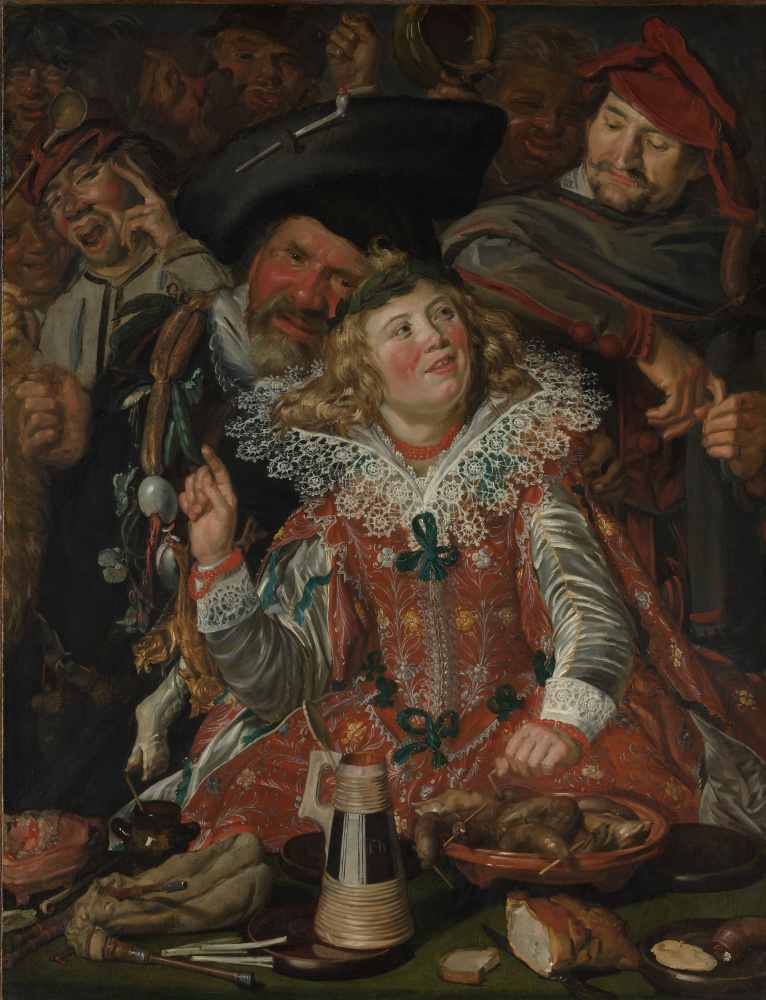log in
Enter site
Login to use Arthive functionality to the maximum
Shrovetide Revellers (Merrymakers at Shrovetide)
Frans Hals • Painting, 1617, 131.4×99.7 cm
Description of the artwork «Shrovetide Revellers (Merrymakers at Shrovetide)»
Frans Hals is a great painter of the Dutch Golden Age. His clients were burghers, nobles, scientists, rifle companies and guardianship councils. For his own pleasure, he painted children, actors, musicians, innkeepers, fishermen, beggars, etc. He liked to unite the subjects in a common movement, to catch them in an unfinished, blurry gesture.
The Shrovetide Revellers (Merrymakers at Shrovetide) painting by the still quite young Hals depicts Shrovetide masquerade — it is a rare case when the artist provides the viewer with a subject matter. Such verbosity is not peculiar to him, because his main niche was portraits. Moreover, The Pancake Queen is filled with symbols so much loved by Holland, but unappreciated by Hals — the costumes of the gentlemen claiming the beauty’s attention immediately inform viewer what she can expect from them.
The outfit of the man in black is adorned with a necklace of small sausages and an empty eggshell, there is a saggy bagpipe on the table beside him, which means that he would be useless in love. The red beret of the gentleman leaning on the back of the “royal throne” with a Mephistophelesian look has one but very weighty sausage on it and a whole dish of sausages is on “his” edge of the table.
The main thing was not the spicy meaning, which was understandable to every viewer of that time, but the convincing liveliness of the facial expressions of all three subjects. Unlike most of his contemporaries, Hals seemed to not think about the muscles causing smile, fixing not anatomy, but a momentary impression — a dimple on the cheek, the shine of teeth wet from saliva, squinting eyes sparkling with laughter.
For liveliness of the painting, Hals was forgiven for insufficient details and creative hooliganism — he often did not make underpainting, he tended to paint in one or two sessions, he could even carelessly wipe part of the background with his palm, never particularly focused on the fabric texture, giving only their hint (and still very few artists could paint fur, cloth, crumpled lace and linen so convincingly). But the real miracle of the great Haarlemian was the laughter of his subjects — the most elusive part of human facial expressions, which he could catch with the tip of his brush.
Author: Oksana Sanzharova.
The Shrovetide Revellers (Merrymakers at Shrovetide) painting by the still quite young Hals depicts Shrovetide masquerade — it is a rare case when the artist provides the viewer with a subject matter. Such verbosity is not peculiar to him, because his main niche was portraits. Moreover, The Pancake Queen is filled with symbols so much loved by Holland, but unappreciated by Hals — the costumes of the gentlemen claiming the beauty’s attention immediately inform viewer what she can expect from them.
The outfit of the man in black is adorned with a necklace of small sausages and an empty eggshell, there is a saggy bagpipe on the table beside him, which means that he would be useless in love. The red beret of the gentleman leaning on the back of the “royal throne” with a Mephistophelesian look has one but very weighty sausage on it and a whole dish of sausages is on “his” edge of the table.
The main thing was not the spicy meaning, which was understandable to every viewer of that time, but the convincing liveliness of the facial expressions of all three subjects. Unlike most of his contemporaries, Hals seemed to not think about the muscles causing smile, fixing not anatomy, but a momentary impression — a dimple on the cheek, the shine of teeth wet from saliva, squinting eyes sparkling with laughter.
For liveliness of the painting, Hals was forgiven for insufficient details and creative hooliganism — he often did not make underpainting, he tended to paint in one or two sessions, he could even carelessly wipe part of the background with his palm, never particularly focused on the fabric texture, giving only their hint (and still very few artists could paint fur, cloth, crumpled lace and linen so convincingly). But the real miracle of the great Haarlemian was the laughter of his subjects — the most elusive part of human facial expressions, which he could catch with the tip of his brush.
Author: Oksana Sanzharova.




